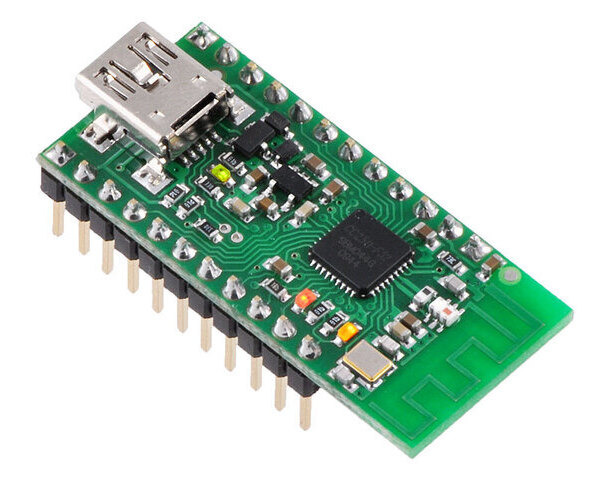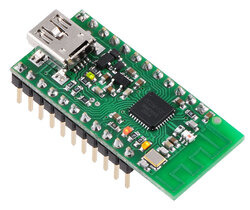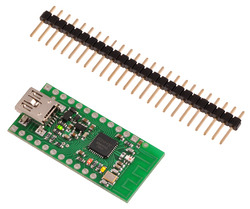Wixels »
Wixel Programmable USB Wireless Module (Fully Assembled)
The Pololu Wixel is a general-purpose programmable module featuring a 2.4 GHz radio and USB. You can write your own software or load precompiled, open-source apps onto the TI CC2511F32 microcontroller at the heart of the Wixel, turning it into a wireless serial link, data logger, or whatever you need for your current project. With 29 KB of available flash and 4 KB of RAM, the Wixel is even suitable as the main controller for a robot or other system. This version ships with 0.1" male header pins installed as shown.
Alternatives available with variations in these parameter(s): partial kit? Select variant…
| Description | Specs (11) | Pictures (10) | Resources (21) | FAQs (2) | On the blog (5) | Distributors (0) |
|---|
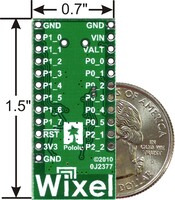 |
Wixel programmable USB wireless module, bottom view with US quarter for size reference. |
|---|
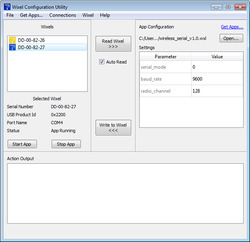 |
The Wixel Configuration Utility with 2 Wixels connected and an App file open. |
|---|
Overview
The Pololu Wixel is a general-purpose programmable module featuring a 2.4 GHz radio and USB. The Wixel is based on the CC2511F32 microcontroller from Texas Instruments, which has an integrated radio transceiver, 32 KB of flash memory, 4 KB of RAM, and a full-speed USB interface. A total of 15 general-purpose I/O lines are available, including 6 analog inputs, and the 0.1" pin spacing makes the Wixel easy to use with breadboards and perfboards. These features give you three main ways to use this general-purpose module:
- Directly connect the Wixel to a PC to create a wireless USB dongle.
- Add USB connectivity to your project via the Wixel.
- Add wireless capabilities to a remote, self-powered device.
A single Wixel can be used as a computer-interface device, such as a USB-to-serial adapter, and it can even serve as the main controller for your system. Connecting the Wixel to a computer requires a USB A to Mini-B cable or a USB A to Mini-B adapter (not included). Two or more modules are required to take advantage of the Wixel’s wireless capabilities.
The Wixel features a built-in USB bootloader that can be used in conjunction with our free Wixel Configuration Utility software to upload custom programs or precompiled, open-source apps to the Wixel (no external programmer is required). Our growing selection of free apps lets you turn the Wixel into whatever you need for your current project. No programming experience or compiler software is required to use these apps: simply download a different app to reuse the Wixel in your next project! We plan to release additional apps in the future for wireless AVR programming, wireless sensing, wireless motor driver interfaces, and more. Read more about the available apps…
Advanced users can modify apps to suit the needs of their specific projects, and the apps serve as examples for programming the CC2511. The Pololu Wixel SDK Repository on GitHub is the central location for obtaining source code and sharing modifications with the community.
Warning about radio regulations: The Wixel has not been tested or certified for conformance with any radio regulations, and the Wixel is shipped with only a bootloader that does not use the radio. The 2.4 GHz band is relatively unrestricted in many parts of the world, but it is your responsibility to comply with your local regulations if you program your Wixel to use its wireless capabilities. More information…
The Wixel as a Wireless Serial Port
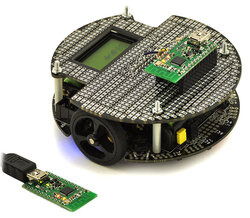 |
Wireless PC control of a 3pi robot using a pair of Wixels. |
|---|
Our Wireless Serial App turns a single Wixel into a USB-to-serial adapter and a pair of Wixels into a wireless USB/TTL serial link for communication between two microcontrollers (like an XBee link) or between a PC and a microcontroller. Among many other things, you can use this versatile app to enable communication between two robots or to remotely monitor or control a robot from a computer. A special version of this app is designed for use with our Wixel shield for Arduino, which makes it easy to add wireless capabilities (including wireless programmability) to an Arduino or Arduino clone.
Using an RF bit rate of 350 kbps, the serial app is capable of transmitting or receiving up to 10 KB of data per second and can reach a range of approximately 50 feet (under typical conditions indoors), and multiple serial links can be used simultaneously on different channels.
Wixel Pinout and Peripherals
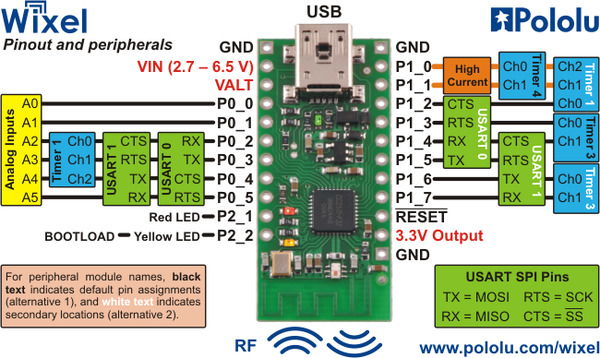 |
The Wixel operates at a 3.3 V logic level, and its I/O lines are not 5V-tolerant. You must use level-shifters, diodes, or voltage dividers to connect the Wixel to outputs from 5V systems. Our bidirectional logic level shifter works well for this.
Main Features
- Full-speed USB
- 2.4 GHz Radio with 256 available channels that can be configured dynamically
- Programmable through USB bootloader (no external programmer required)
- Pre-compiled, open-source apps available
- Wixel SDK for developing your own applications in C using open source tools and libraries
- 0.1" pin spacing (compatible with standard breadboards and 0.1" perfboards)
- 3 indicator LEDs
- 15 user I/O lines, featuring 6 analog inputs, 2 USARTs (for serial or SPI), and 7 timer channels (capable of PWM)
- 4 KB of RAM and 29 KB of application program memory (flash)
- Comprehensive user’s guide
Specifications
- Operating voltage: 2.7 – 6.5 V
- Operating current: up to approximately 30 mA (can get down to ~100 μA when in sleep mode)
- Radio
- Frequency: 2400 – 2483.5 MHz
- Range: approximately 50 feet (under typical conditions indoors)
- Bit rate: programmable, up to 350 kbps
- Effective data rate: up to 10 KB/s
- Size: 0.7" × 1.5"
- Weight without header pins installed: 3.2 g
Included Hardware
The Wixel is available in two versions:
The fully-assembled version ships with its header pins soldered in, so it is ready to be connected to your project with no soldering required.
The partial kit version ships with everything installed except the header pins. A 25×1 straight 0.1" male header strip is included as shown in the right picture below. This version is ideal for compact installations and allows flexibility in choice of connectors.
|
|
